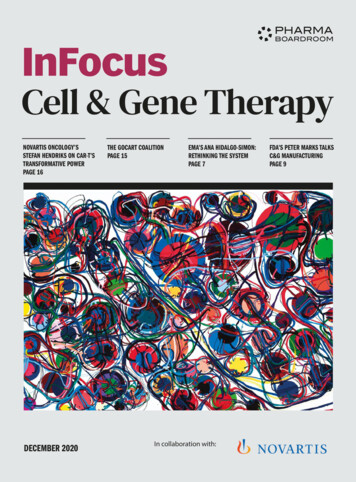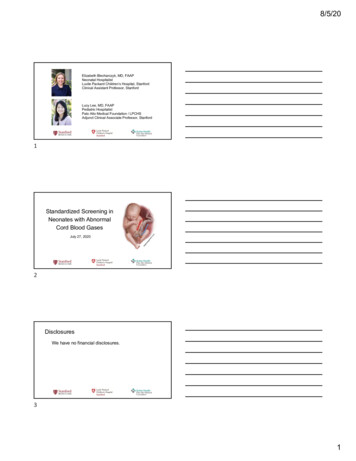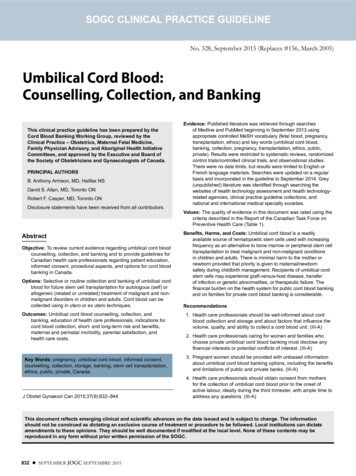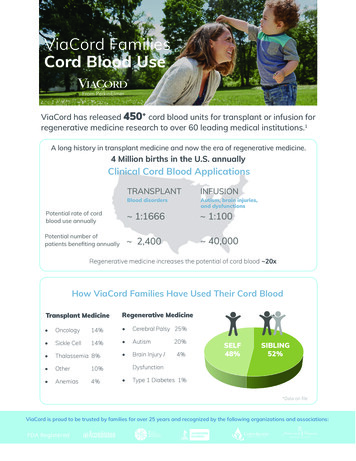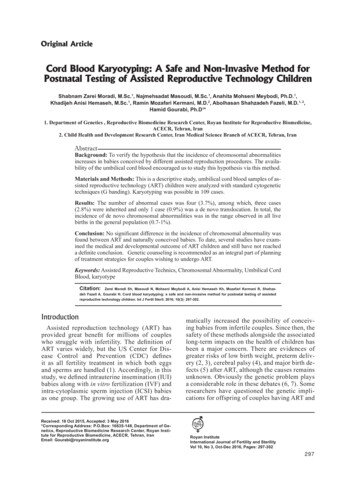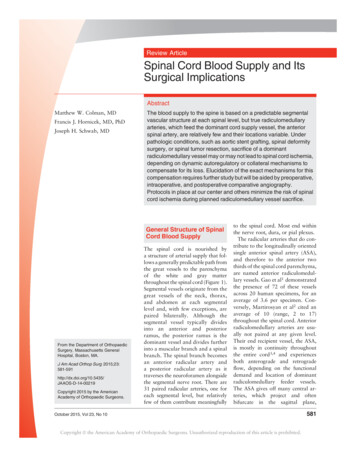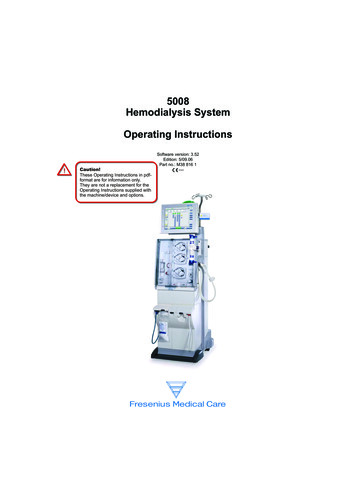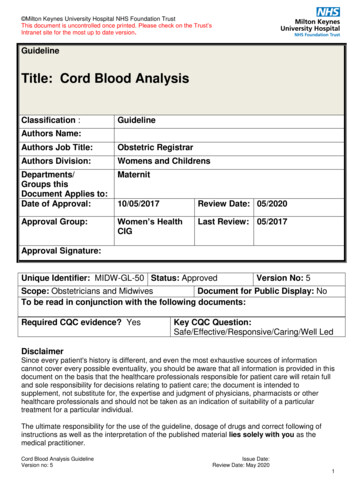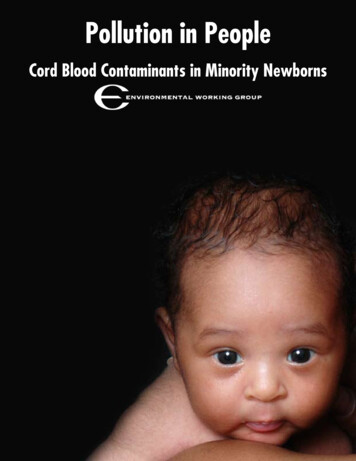
Transcription
Pollution in Peopleewg.orgCord Blood Contaminants in Minority Newborns1
Table of ContentsExecutive Summary3Findings6Chemical MixturesEpigeneticsProving Harm at Low Doses252829Vulnerability in Early Life34Minority Children and Chemical Risks35Appendix A:Methodology38Appendix B:A Review of U.S. Cord Blood Contaminant Studies43Appendix C:References55
ewg.orgExecutive SummaryA two-year study involving five independent research laboratories in the United States,Canada and the Netherlands has found up to 232 toxic chemicals in the umbilical cordblood of 10 babies from racial and ethnic minority groups. The findings constitute hardevidence that each child was exposed to a host of dangerous substances while still in itsmother’s womb.The research, commissioned by the Environmental Working Group in partnership withRachel’s Network, marks the most extensive investigation of the particular environmentalhealth risks faced by children of African American, Hispanic and Asian heritage.The laboratory analyses represent the first reported detections in American newborns for21 contaminants. Among them: Bisphenol A (BPA), a derivative of the petrochemical benzene essential to themanufacture of tough polycarbonate plastic and epoxy resins that are fabricatedinto a wide variety of modern products, including metal food cans, hard plasticinfant formula bottles, water bottles, safety helmets and glasses, television,computer and cell phone housings, compact discs and high performance coatings.BPA is a synthetic estrogen that researchers have found to disrupt the endocrinesystem, disrupt normal reproductive system development and diminish test animals’intellectual and behavioral capacity. Tetrabromobisphenol A (TBBPA), a fire retardant for circuit boards that interfereswith thyroid function and may inhibit the production of T cells the body uses to fightdisease, undermining immune defenses against bacteria, viruses and cancer. TBBPAcan break down to BPA, and when incinerated it creates brominated dioxins, whichare considered likely human carcinogens. Galaxolide and Tonalide, polycyclic musks that are synthetic fragrances incosmetics, laundry detergent and other scented products and that have beendetected in numerous biomonitoring studies of pollution in people and in the aquaticenvironment. Perfluorobutanoic acid (PFBA, or C4), a member of the perfluorocarbon (PFC)chemical family used to make non-stick, grease-, stain- and water-resistant coatingsfor consumer products, including brands Teflon, Scotchgard and Goretex. The moststudied PFCs, the Teflon chemical PFOA and the Scotchgard chemical PFOS, arelinked to cancer, birth defects and infertility. PFCs are extremely persistent in theenvironment. There is almost no toxicological data for PFBA in the public domain. 8 Previously Undetected Polychlorinated biphenyls (PCBs). Developed asindustrial lubricants, coolants and insulating materials, also used in caulk, PCBswere effectively banned in the late 1970s but are long-lasting in the environment.The U.S. government lists PCBs as probable human carcinogens. According togovernment and academic scientists, PCBs have been shown to disrupt the endocrinesystem and damage the immune system, and are toxic to the developing brain.3
Pollution in People - Cord Blood Contaminants in Minority NewbornsSome racial and ethnic minority communities inthe U.S. experience disproportionate exposuresto environmental pollution (Brulle and Pellow2006). Whether through poverty or historical patterns of discrimination, some are morelikely to live near busy roads, industrial sitesand in older housing. These factors, combinedwith workplace exposures, diet and use ofcertain consumer products, may lead to greatercontamination with chemicals. When combinedwith poor nutrition and health, the adverse effects of having a greater chemical body burdencan be aggravated.In spite of the acute need to understand prenatal exposures in all segments of Americansociety, EWG could find no studies that examined the chemical body burden in the womb forminority children. This study is a first attemptto fill that void.The 10 children in this study were born between December 2007 and June 2008 in Michigan, Florida, Massachusetts, California andWisconsin. They are otherwise anonymous.We have no way of knowing anything about thehomes and neighborhoods into which they wereborn. This study tested for chemicals that canbe found in virtually every American household.We did not test for chemicals, such as thebyproducts of smoking or alcohol consumption,that would indicate behaviors by the motherthat could in any way jeopardize the health ofthe child. We also did not test for chemicalsfrom local pollution sources.We cannot determine how chemical exposuresin utero may vary from one community toanother, but our results strongly suggest thatthe health of all children is threatened by traceamounts of hundreds of synthetic chemicalscoursing through their bodies from the earlieststages of life.What’s Unique About EWG’sBiomonitoring Research?This study is EWG’s eleventh biomonitoringinvestigation. To date, EWG studies havefound 414 industrial chemicals, pollutantsand pesticides in 186 people, from newbornsto grandparents. Our goal is to quantify thepollution in people, or what we call the “humantoxome,” and to drive science and policychanges to protect public health.The Centers for Disease Control and Prevention(CDC) has published biomonitoring study resultsinvolving thousands of people nationwide overthe past decade. Its next report, the fourth ina series, is expected to list detections of morethan 200 pollutants found in representativesamples of the U.S. population.EWG’s biomonitoring program complements theCDC in three key respects:1. More chemicals: CDC looks for fewerchemicals, but in larger, statisticallyrepresentative samples of theU.S.population. EWG studies typicallylook for more chemicals than the CDC,but in smaller sample cohorts. EWG hasdetected more than 414 chemicals in people,compared to 203 reported by the CDC. EWGrelies on specialized laboratories around theworld to maximize the scope of its analyses.2. Mixtures in each person: CDC reports itsresults chemical by chemical, estimatinghow many Americans are exposed to eachchemical under investigation. EWG publishesthe full list of chemicals found in eachperson tested to convey the scope andcomplexity of each person’s body burden.3. Early life exposures: CDC tests adults andchildren age 6 and up. The agency rarelytests cord blood or infants. EWG studiesinclude cord blood, infants and toddlers tohelp document exposures during the mostvulnerable periods of development.4
ewg.orgThe contaminants found in these children are from unintended exposures to some of the mostproblematic consumer product and commercial chemicals ever put on the market. Theirpresence in fetal cord blood represents a significant failure on the part of the Congress andgovernment agencies charged with protecting human health.Scientists know far too little about the health threats posed by exposure to toxic chemicals in thewomb. There is broad agreement, however, that the dangers are greater when exposure occursbefore birth. Just how much more dangerous is not known.Brominated flame retardants, PCBs, the Teflon chemical PFOA and the Scotchgard chemicalPFOS, BPA, lead, mercury, perchlorate, dioxins and furans are all considered either likelyhuman carcinogens, serious neurotoxins or well-established hormone disrupters, according togovernment health authorities. Many are strongly linked to more than one of these effects.RecommendationsGovernment, academic and independent biomonitoring studies, including those by EWG, havedetected up to 358 industrial chemicals, pesticides and pollutants in the cord blood of Americaninfants. Exploring the so-called “additive” effects of possible carcinogens, hormone disruptersand neurotoxins is a new and urgent priority for environmental health scientists. EWG supportsthis very important work.But as this science moves forward, we need to act now to reduce exposures that present thegreatest health threats based on what we know today, even as scientists struggle to understandhow the cocktail of chemicals in the womb could harm current and future generations.Many of the up to 232 compounds detected in this study have been the target of regulatoryaction and government controls. As a rule, however, these actions came far too late, well afterthe environment and the human race were polluted to a degree that has raised serious healthconcerns. Our failure to act quickly has ensured that these chemicals will continue to pollutefuture generations for decades, even centuries to come.EPA Administrator Lisa Jackson has identified several of the substances found in this study aspriority chemicals of concern. These include BPA, brominated flame retardants and the entireclass of perfluorinated (Teflon and Scotchgard) chemicals.In our view, any chemical found in cord blood should be a top candidate for tough regulatoryaction to protect public health.To ensure a full accounting of chemical exposure before birth, we recommend that the CDCinitiate a comprehensive cord blood-testing program. This work should be coordinated withongoing biomonitoring in the National Children’s Study but should seek to identify and quantifythe full extent of chemical exposures in the womb over time. The complete costs of this workmust be borne by industry.5
Pollution in People - Cord Blood Contaminants in Minority NewbornsFindingsThe Environmental Working Group, in partnership with Rachel’s Network, commissioned fivelaboratories in the U.S., Canada, and Europe to analyze umbilical cord blood collected from10 minority infants born in 2007 and 2008. Collectively, the laboratories identified up to 232industrial compounds and pollutants in these babies, finding complex mixtures of compounds ineach infant.This research demonstrates that industrial chemicals cross the placenta in large numbers tocontaminate a baby before the moment of birth. Test results are shown below.Chemicals Detected in Umbilical Cord Blood from 10 Minority NewbornsChemical or chemicalfamilyGeometric Mean(of the detections)RangeMetals [µg/dL (wet weight) in whole blood] - 3 of 3 foundLead [pollutant fromlead-based paint in olderhomes, household dust,0.348 µg/dL(0.222 - 0.549)vinyl products; harmsbrain development andfunction]Mercury [pollutant fromcoal-fired power plants,mercury-containingproducts, and certain0.64 µg/dL(0.09 - 3.91)industrial processes;accumulates in seafood;harms brain development and function]Methylmercury [organicform of mercury typical0.513 µg/dL(0.08 - 3.28)ly found in contaminatedfish and seafood]Number of newborn umbilicalblood sampleswith detectionsNumber ofchemicalsdetectedwithin chemical family10 of 10NA10 of 10NA10 of 10NA6
ewg.orgChemical or chemicalfamilyGeometric Mean(of the detections)RangeNumber of newborn umbilicalblood sampleswith detectionsNumber ofchemicalsdetectedwithin chemical familyPolybrominated dibenzodioxins and furans (PBDD/F) [pg/g (lipid weight) in blood serum] - contaminantsin brominated flame retardants; pollutants and byproducts from plastic production and incineration; accumulate in food chain; toxic to developing endocrine (hormone) systemTested for: 6Brominated dioxin34.57 pg/g(0 - 41.8)2 of 10Found: 1Tested for: 6Brominated furan292 pg/g(0 - 1440)4 of 10Found: 5Perfluorinated chemicals (PFCs) [ng/g (wet weight) in whole blood] - active ingredients or breakdownproducts of Teflon, Scotchgard, fabric and carpet protectors, food wrap coatings; global contaminants;accumulate in the environment and the food chain; linked to cancer, birth defects and morePerfluorochemicalsTested for: 132.38 ng/g(0.736 - 7.08)10 of 10(PFCs)Found: 6Polybrominated diphenyl ethers (PBDEs) [ng/g (lipid weight) in blood serum] - flame retardant in furniture foam, computers and televisions; accumulates in the food chain and human tissues; adversely affectsbrain development and the thyroidTested for: 46Polybrominated diphenyl7.28 ng/g(3.05 - 15.1)10 of 10Found: 26 toethers (PBDEs)291Polychlorinated naphthalenes (PCNs) [ng/g (lipid weight) in blood serum] - wood preservatives, varnishes,machine lubricating oils, waste incineration; common PCB contaminant; contaminate the food chain;cause liver and kidney damageTested for: 70Polychlorinated naphtha0.64 ng/g(0.0743 - 3.43)10 of 10Found: 17 tolenes (PCNs)242Polychlorinated biphenyls (PCBs) [ng/g (lipid weight) in blood serum] - industrial insulators and lubricants; banned in the U.S. in 1976; persist for decades in the environment; accumulate up the food chainto humans; cause cancer and nervous system problemsTested for:Polychlorinated biphe20922.1 ng/g(9.68 - 39.7)10 of 10nyls (PCBs)Found: 98 to14437
Pollution in People - Cord Blood Contaminants in Minority NewbornsChemical or chemicalfamilyGeometric Mean(of the detections)RangeNumber of newborn umbilicalblood sampleswith detectionsNumber ofchemicalsdetectedwithin chemical familyPolychlorinated dibenzodioxins and furans (PCDD/F) [pg/g (lipid weight) in blood serum] - pollutants,by-products of PVC production, industrial bleaching and incineration; cause cancer in humans; persist fordecades in the environment; very toxic to developing endocrine (hormone) systemTested for: 7Chlorinated dioxin52.6 pg/g(5 - 383)10 of 10Found: 6Tested for: 10Chlorinated furan16.3 pg/g(0 - 278)6 of 10Found: 9Bisphenol A (BPA) [ng/mL (wet weight) in blood serum] - building block of polycarbonate plastics and epoxy resins for thousands of consumer products, including baby bottles, drinking water containers, metalfood and beverage can liners and dental sealants; linked to hormone disruption, birth defects and cancerBisphenol A2.8 ng/mL(0 – 8.61)9 of 10NA3 of 10NA9 of 10NABrominated fire retardant [ng/g (lipid weight) in blood serum] - 1 of 1 foundBrominated Fire Retardant2986 ng/g(0 - 3210)Perchlorate [µg/L (wet weight) in whole blood] - 1 of 1 foundPerchlorate0.231 µg/L(0 - 0.6)Polycylic musks [ng/g (wet weight) in whole blood] – heavily used synthetic fragrances that mimic naturalmusk.Polycylic musks0.835 ng/g(0 - 2.74)7 of 10Tested for: 6Found: 2Notes:1.) Numbers are expressed as a range because several PBDEs are tested for in pairs; a positive result maymean one or both are present. The range reflects the minimum and maximum number of possible positiveresults.2.) Numbers are expressed as a range because many PCNs are tested for in groups of two or threechemicals; a positive result may mean that one, some, or all are present. The range reflects the minimumand maximum number of possible positive results.3.) Numbers are expressed as a range because many PCBs are tested for in groups up to six at a time: apositive result may mean that one, some, or all are present. The range reflects the minimum and maximumnumber of possible positive results.8
ewg.orgBPA – plastics chemicalKey findings: First ever detection of BPA in U.S. cord blood. Found in 9 of 10 cord blood samples tested.What is it? - BPA is a petrochemical derivative used to toughen polycarbonate plastic and epoxyresin.How does it contaminate cord blood? – BPA is found in food, beverages and infant formula soldin metal cans (lined with BPA-based epoxy resin), drinks in polycarbonate plastic containers(made from BPA). Because epoxy resin and polycarbonates are unstable, BPA in food packagingleaches readily into any food or liquids the packaging touches.Health risks - BPA acts as a synthetic estrogen that disrupts the endocrine system andcauses other harmful effects, even at very low doses. In test animals, BPA induces abnormalreproductive system development, diminishes intellectual capacity, causes behavioral problemsand has induced reproductive system cancer, obesity, diabetes, early puberty, resistance tochemotherapy, asthma, cardiovascular system problems and other chronic ailments.Regulatory status – The FDA is considering whether to regulate BPA in food packaging. Minnesotaand Connecticut, Chicago, Suffolk County, N.Y., and Schenectady County, N.Y., have banned BPAin baby bottles and other children’s food containers and utensils, and Massachusetts has issueda strong warning against them. In 2009, bills to ban or restrict BPA were introduced in the U.S.Congress and 21 states. Major baby bottle and sports bottle makers have voluntarily switched tonon-BPA plastics, but the food canning industry has not developed non-BPA linings for metal cans.Discussion:Tests performed by the Division of Biological Sciences at the University of Missouri-Columbiaidentified BPA in cord blood from 9 of 10 minority newborns. Cord blood studies in Asia andEurope have found traces of BPA in cord blood, but until now, scientists have not reported findingthe chemical in cord blood of American infants.The impact on human health of BPA, a ubiquitous plastic component detected by CDC researchersin 93 percent of Americans over age 6 (Calafat 2008), is a major research priority for federalscientific institutions and major independent research laboratories around the world.Scientists discovered that BPA was a synthetic estrogen as early as 1936, but exposure to tracesof the chemical was thought to be harmless until 1997, when a team led by Missouri biologistFrederick Vom Saal demonstrated that very low doses of BPA caused irreversible damage to theprostates of fetal male mice. Since then, scores of animal studies have produced substantialevidence that BPA disrupts the endocrine system, even at the very small concentrations to whichpeople are typically exposed, and may cause a lengthening list of serious disorders.9
Pollution in People - Cord Blood Contaminants in Minority NewbornsAmong them are: Endocrine system disruption Cancer Impaired brain function and behavioral abnormalities Cardiovascular disease Infertility and miscarriage Obesity and diabetes Asthma Resistance to chemotherapy Epigenetic and transgenerational effectsA rare human epidemiological study, published in November 2009 in the journal HumanReproduction, offers what its authors called “the first evidence that exposure to BPA in theworkplace could have an adverse effect on male sexual dysfunction.”In 2008, the National Toxicology Program, an authoritative interagency science panel housedat the National Institute for Environmental Health Sciences, concluded that BPA may harm thebrain, behavior and prostate gland of fetuses, infants and children, even at the low doses towhich people are currently exposed. (NTP 2008). NTP officials called for more intensive researchon BPA on the grounds that “the possibility that BPA may affect human development cannot bedismissed.”In response, in October 2009, NIEHS Director Linda Birnbaum targeted 30 million in federalstimulus funds to basic research on BPA and human health.Children, African Americans and the poor may face heightened health threats from bisphenol A.The CDC has found average BPA levels 80 percent higher in children ages 6-11 than in adults over20 (Calafat 2008). These surveys have also detected BPA levels 24 percent higher in people fromhouseholds with annual incomes under 20,000 versus 45,000 or more, and 11 percent higheramong non-Hispanic blacks than whites.In 2008, citing two industry-sponsored studies, the FDA deemed low-dose BPA exposure safe, evenfor pregnant women and infants. At the urging of its Science Board and 33 university scientistsand independent experts, the agency is now reassessing the safety of BPA in food packaging.10
ewg.orgPerchlorate (rocket fuel oxidizer)Key Findings: Found in 9 of 10 cord blood samples. This is just the second study to find perchlorate inAmerican babies; the first was published in September 2009 and reported results from childrenborn in New Jersey.What is it? – Perchlorate is a rocket fuel oxidizer that powers missiles, the space shuttle,fireworks, road flares, automobile airbags and more.How does it contaminate cord blood? – It seeps into soil and groundwater because of improperstorage and disposal at defense and aerospace facilities and chemical plants. Water utilities in 35states and territories have found perchlorate in drinking water. The FDA detected perchlorate in74 percent of 285 popular foods and beverages tested, including baby food.Health risks – Perchlorate can block the formation of thyroid hormones critical to braindevelopment and growth in the fetus, infants, and children. Inadequate iodine intake increasesthe risk of perchlorate-related compromise of thyroid hormone production.Regulatory status – EPA is re-evaluating the need for a national drinking water standard.Massachusetts and California have set standards for maximum perchlorate pollution in drinkingwater. The FDA has taken no action to address perchlorate contamination of food.Discussion:Nine of 10 cord blood samples in the current study tested positive for perchlorate. This is thesecond study to test U.S. cord blood for perchlorate. In the first, published in September 2009,CDC researchers reported the compound in 67 percent of cord blood samples from 126 babiesborn in New Jersey (Blount et al 2009).Perchlorate, a component of rocket fuel integral to the firing systems of missiles and somemilitary explosives, has been found to contaminate drinking water in 28 states and territories.The chemical has seeped into groundwater and soil at military and aerospace sites and chemicalplants and has entered the food supply through polluted irrigation water, certain naturallycontaminated fertilizers, and other routes not yet identified.In a national biomonitoring study, CDC detected perchlorate in the urine of all 3,000 peopletested (Blount et al 2006a), indicating widespread exposure in the U.S. population. FDAtesting has found perchlorate contamination in 74 percent of 285 commonly consumed foodsand beverages, including baby food (Murray et al 2008). CDC scientists have found widespreadperchlorate contamination of powdered infant formula, especially brands derived from cow’s milk(Schier et al 2009).Adequate levels of thyroid hormone are critical to brain development and growth of the fetus.A recent large-scale epidemiological study by the CDC found that among women, currentperchlorate exposures are associated with significant effects on thyroid hormone levels,especially in those with lower iodine levels (Blount et al 2006b). This is of special concern inwomen of childbearing age, who may experience perchlorate-associated fluctuations in thyroidhormone levels during pregnancy (EWG 2006).11
Pollution in People - Cord Blood Contaminants in Minority NewbornsPerfluorochemicals (PFCs) - Teflon and Scotchgard chemicalsKey findings: First test in the world for PFBA (C4 or perfluorobutanoic acid) in cord blood; found in 1 of 10infants. PFOA (perfluorooctanoic acid) and PFOS (perfluorooctanesulfonate) found in 10 of 10 infants.What are they? – PFCs are stain- and grease-proofing chemicalsHow do they contaminate cord blood? – used in a variety of consumer products, such ascarpets and furniture, as stain and grease repellents, in Teflon cookware, food packaging andclothing. PFCs have also been found in drinking water and certain food groups such as fruits andvegetables.Health risks – PFCs are linked in human studies to a broad range of health risks, includingdecreased birth weight, reproductive problems, and elevated cholesterol. In animal studies, PFCexposure has been associated with immune suppression and liver, pancreatic and breast cancers.Regulatory status – In 2002, 3M Corporation, the world’s major manufacturer of PFOS, completedits voluntary phase-out of the chemical’s production after the EPA raised concerns aboutits toxicity and widespread detection in human biomonitoring surveys. The EPA is currentlydeveloping drinking water standards for both chemicals.Discussion:One cord blood sample contained the first-ever finding in cord blood of PFBA, a PFC that appearsto be a legacy pollutant. According to the CDC and the EPA, PFBA was last produced in the US in1998.This child, the first baby in the world found to be contaminated with this stain- and greaseproofing compound, joins 13 other Americans with PFBA in their blood, according to tests of 75children and adults sponsored by EWG. Scientists know very little about its possible toxicity.All 10 cord blood samples in this study tested positive for two members of the PFC family, PFOAand PFOS, confirming CDC studies that found widespread exposure to these chemicals throughoutthe U.S. population.PFCs contaminate food, water, wildlife and consumer products and have been detected in everycorner of the globe. In the human body, these chemicals are persistent and bioaccumulative andhave been found in breast milk.12
ewg.orgResearchers at the Johns Hopkins Bloomberg School of Public Health tested PFOA and PFOS levelsin nearly 300 mother/infant pairs and found that women with elevated blood levels of thesechemicals gave birth to infants with reduced birth weight and head circumference (Apelberg2007). Low birth weight is a predictor of potentially serious medical problems later in life (Lauand Rogers 2004). Other human studies have linked PFC exposure to difficulty conceiving, lowersperm quality and elevated cholesterol (Fei et al 2009, Joensen et al 2009, Steenland et al2009).Concerns about PFOS have prompted an end to U.S. production. Manufacturers have agreed tophase out PFOA. EPA administrator Lisa Jackson recently announced that PFCs are one of sixchemicals or chemical classes being considered for priority action (EPA 2009). EPA is developingdrinking water standards for both chemicals.13
Pollution in People - Cord Blood Contaminants in Minority NewbornsLeadKey findings: Lead was found in cord blood of 10 of 10 newborns tested.What is it? – Lead is a neurotoxic metal that concentrates in the brain.How does it contaminate cord blood? – Lead contamination occurs primarily as a result ofmothers ingesting or breathing dust from chipped lead paint in older homes or drinking tap watercontaining lead that leaches from old water pipes, lead solder and brass plumbing fixtures.Health risks – It is a known human neurotoxin believed unsafe in any amount. More than 30 yearsof studies have demonstrated lead’s dangers to children at lower and lower doses.Regulatory status – Lead was banned in gasoline and paint decades ago, but many other usesremain. Some states are moving to eliminate lead from consumer goods ranging from wheelweights to cosmetics to children’s products.Discussion:All 10 newborns in this study had measurable amounts of lead in their cord blood, consistent withprevious studies that have found that babies are often contaminated with this neurotoxic metalbefore birth.Lead is one of only a handful of substances whose effects in people have been well studied. TheEPA lists a litany of health problems linked to lead, including brain and nervous system damage,behavior and learning problems, hyperactivity, slowed growth, hearing problems, reproductiveproblems and nerve disorders (EPA 2009a).Three decades of research have shown clearly that lead damages the human brain. Advances incognitive and behavioral testing have allowed researchers to discern harm at lower and lowerexposures. There is no known safe threshold for exposure.In February, 2009, researchers at Jagiellonian University in Krakow, Poland, published a studyin the journal Neuroepidemiology demonstrating damage to cognitive function in newbornsexposed to amounts of lead lower than in any previous study – and lower than the amounts foundin several newborns in EWG’s study. The Polish researchers found a strong correlation betweenlead levels in cord blood at birth and deficits in cognitive performance in 12-, 24- and 36-monthold children. The median level they detected in cord blood was one-tenth of the current U.S.exposure standard for young children (Jedrychowski 2009). The lead levels EWG measured inminority newborns were about half the typical level in the Polish children.Despite lead’s hazards, a wide range of industries still use it. It is manufactured, imported,processed or used in at least 8,200 facilities in all 50 states, according to company reporting oflead use and emissions in EPA’s 2007 Toxics Release Inventory. Lead-acid batteries -- used in cars,trucks and power supplies for computers, telecommunication networks and hospitals -- accountfor 88 percent of current lead use, but it also shows up in products such as crystal chandeliersand radiation shields.14
ewg.orgFor most Americans, lead exposure comes from contaminated drinking water (lead leaches fromlead pipes, solder and brass plumbing fixtures) or from dust from chipping paint in older homes.Children living near industrial facilities may face higher exposures.Americans’ exposures were far higher until the EPA took steps 30 years ago to restrict lead ingasoline and house paint. Subsequently, the number of children exposed to lead above thegovernment’s action level (10 micrograms per deciliter of blood) fell from 87.4 percent to 3.1percent as of 2001. Public health advocates declared the results a great victory.Today, some children remain highly exposed, particularly among non-Hispanic blacks and MexicanAmericans, children from lower socioeconomic groups and immigrants (CDC 2005). A range ofconsumer products, including many marketed for children, still contain lead. In recent years,lead has been reported in lunch boxes, lipstick, jewelry, window blinds and imported candy.15
Pollution in People - Cord Blood Contaminants in Minority NewbornsMercuryKey findings: Total mercury and methylmercury found in 10 of 10 newborns tested.What is it? – Mercury is a pollutant from coal-fired power plants and other industrial sources,also used in consumer products such as fluorescent light bulbs and thermometers. Mercuryin elemental form pollutes waterways. I
tests cord blood or infants. EWG studies include cord blood, infants and toddlers to help document exposures during the most vulnerable periods of development. Some racial and ethnic minority communities in the U.S. experience disproportionate exposures to environmental pollution (Brulle and Pellow 2006). Whether through poverty or histori-
